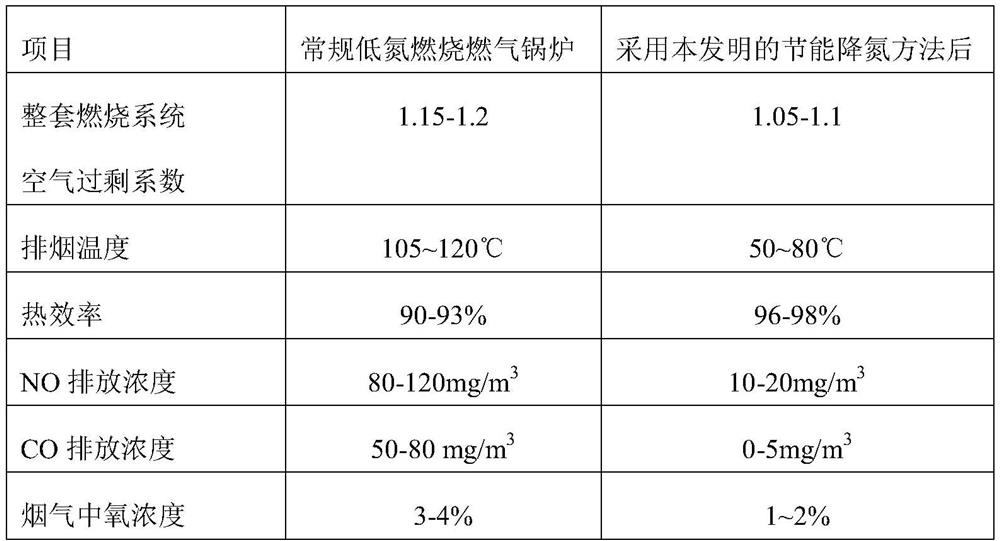[0007] (1) The single low-nitrogen combustion technology has certain defects: In order to control NO emissions, the commonly used nitrogen
reduction methods mainly include fuel
staged combustion, air
staged combustion,
flue gas recirculation combustion, surface combustion, etc.
Staged combustion can reduce NO Emission of 30-50%, but if the
staged combustion air flow organization is not good, it will often cause
flameout or increase of CO emission concentration;
flue gas recirculation combustion reduces NO emission by about 15-40%, but at the same time it will cause
combustion instability, combustion Efficiency is reduced, excessive recirculation volume will cause problems such as surge, and the structure of the flue gas recirculation
system is complex, the cost is high, and the burner head is easily corroded by the circulating flue gas; the fully premixed surface combustion can be maximized In order to suppress NO emissions from gas-fired industrial boilers, the
flame is evenly distributed along the
metal fibers, which greatly reduces the heat per unit area, but the full premixed surface combustion technology requires a large excess air coefficient, which will increase the heat loss of the burner, and at the same time The
fiber combustion probe with special
metal texture is easy to block, it is difficult to clean and maintain in the later stage, and the service life is difficult to guarantee. It has high requirements on the material and manufacture of the burner, and there are problems such as the risk of premixing and short service life.
[0008] (2) SNCR and SCR technology after combustion: the flue gas comes out of the industrial
boiler furnace, and the temperature of the low-temperature flue gas after the
air preheater absorbs heat is usually lower than 150°C. After the condensing
heat exchanger is installed, the flue gas temperature It may even be lower than 80°C. Due to the relatively low flue gas temperature, the SCR at the
tail of the industrial boiler is located in an unsatisfactory flue gas temperature area, resulting in low SCR efficiency, and SCR also has problems such as leakage of
reducing agent ammonia and expensive catalysts. There are potential dangers during use; at the same time, due to the limited space on site of industrial boilers, there is no suitable space for
ammonia and
urea injection areas, so it is difficult to effectively implement SNCR after combustion
[0009] (3) Although the current emerging flameless combustion (low-
oxygen dilution combustion) technology can effectively reduce the emission of
NOx, compared with the traditional staged combustion, the emission of NO in the flue gas can be reduced by more than 70%, but its formation conditions are relatively harsh. Flameless combustion can only be achieved when the temperature of the wall surface of the
boiler furnace reaches above the self-
ignition point of the gas. Therefore, it is extremely difficult to achieve flameless combustion in gas-fired industrial boilers due to the existence of the water-cooled wall of the furnace.
[0012] (1) In gas-fired industrial boilers, due to the existence of the furnace water-cooled wall, the temperature of the furnace water-cooled wall surface is difficult to reach the spontaneous
ignition point of the gas, and the
radiation heat transfer in the furnace is too large. At present, the emerging flameless combustion or soft combustion is in the industrial
boiler furnace The interior cannot be stable, and it is easy to cause
flameout and unstable combustion, so it is extremely difficult to achieve flameless combustion in gas-fired industrial boilers
[0013] (2) In a single low-nitrogen combustion technology, in order to pursue or achieve low-
nitrogen emission effects, the high-efficiency performance of combustion will inevitably be reduced
If the staged combustion
airflow organization is not good, it will cause the
flame to scatter, or the CO emission concentration will increase; at the same time, it will cause
combustion instability or even
flameout, and the combustion efficiency will decrease; when using flue gas circulation combustion, increasing the recirculation amount of flue gas is beneficial Reduction of
nitrogen oxides, but too much recirculated flue gas will lead to
combustion instability, in addition, problems such as burner head being corroded by circulating flue gas, boiler
thermal efficiency decreasing, circulating fan surge, etc.
[0014] (3) The excess air coefficient required by the fully premixed surface combustion technology is large, which will increase the heat loss of the burner. At the same time, the
fiber combustion probe with special
metal texture is easy to block, it is difficult to clean and maintain in the later stage, and it is difficult to guarantee the service life. The material and manufacturing requirements of the device are high, and there are problems such as the risk of premixing and short service life.
[0015] (4) In post-combustion SNCR and SCR technologies, there is no suitable space for spraying
ammonia and
urea at the
tail of industrial boilers, and it is difficult to effectively implement post-combustion SNCR
[0018] In view of the above analysis, controlling the generation of
nitrogen oxides from the source is the first choice to control
nitrogen oxide pollution. However, the existing methods and technologies are all focused on achieving the comprehensive effect of high efficiency and ultra-
low nitrogen emissions through combustion in the furnace. is unrealistic
 Login to View More
Login to View More  Login to View More
Login to View More 


